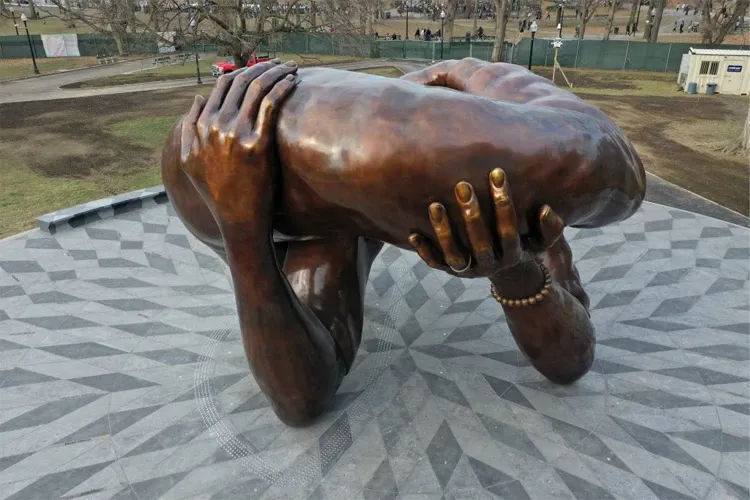In January, new sculptures unveiled in Boston and New York City were met with mixed reviews: fawning by mainstream media and pillory by much of the public.
The first was a $10 million, 18,000-pound behemoth placed on the Boston Common. Called “The Embrace,” the sculpture was intended to memorialize a hug shared between Martin Luther King, Jr. and Coretta Scott King after Dr. King won the Nobel Peace Prize in 1964. While the intention of honoring the Kings was harmless, the sculpture designer’s choice to “eschew tradition and design a memorial that is not a full-body figure” resulted in a confusing morass of disembodied arms, leading a relative of Coretta Scott King to denounce the sculpture with harsh criticisms.
The second sculpture, dubbed “NOW,” was an 8-foot metal statue placed atop a New York City courthouse. The statue depicts a female figure with hair braids twisted into the shape of ram’s horns, tentacle-like protuberances jutting out of the arms and legs, and a lace collar around the neck in the style of the late Supreme Court Justice Ruth Bader Ginsburg. The artist behind the sculpture intended for it to memorialize Ginsburg’s pro-abortion legacy.
In addition to its repulsive form and its celebration of abortion, the metallic statue seems out of place amongst the nine other statues, all made of stone, that adorn the top of the courthouse.
Our culture’s current art seems to have two settings: drab or garish. Both are symptoms of the same disease: our culture’s rejection of objective beauty.
Unfortunately, these statues are emblematic of today’s art, music, fashion, and architecture. As Anthony Esolen notes in his book “Out of the Ashes,” our culture’s current art seems to have two settings: drab or garish.
Drab, soulless, utilitarian buildings dominate many American towns and cities. Our offices, schools, churches, and shopping centers tend to be flat, boxy, and porridge-colored. Modern art exhibits are stuffed with uninspiringly simple works by artists who are likely laughing all the way to the bank. Floppy normcore fashion rages on.
Garishness greets the senses of those who dare to listen to dissonant contemporary music or watch performance art. Brightly-colored fast food restaurants with soaring plastic signs dot the landscape. McMansions tacked with features from wildly different architectural eras riddle the suburbs. Whenever modern art isn’t drab, it is often obscene, violent, blasphemous, or sexually explicit, and the shock value is the point.
The drab and the garish are two symptoms of the same disease: our culture’s rejection of objective beauty.
When an artist chooses to throw away the sound principles of design that have created beautiful things for millennia, it will inevitably lead to dull or ugly art.
When an artist chooses to throw away the sound principles of design that have created beautiful things for millennia, it will inevitably lead to dull or ugly art. Beauty thrives on symmetry, proportion, complementarity, order, rhythm, and ornamentation. Remove too many of these pillars, and a work of art will become boring, chaotic, or meaningless.
Contrary to the widespread pretense that beauty is entirely a matter of individual preference, polls find that overwhelming majorities share one preference when asked, and that preference tends to be for the more traditionally beautiful art. For example, most prefer traditional architecture over more modern styles, and the most sought-after art museums are those that house classical and Christian works.
The motivations of the artist also influence the beauty and longevity of their work. Artists who are preoccupied with radical self-expression and rejection of tradition are the kind who create the likes of “The Embrace” and “NOW.” On the other hand, artists who have in mind the glory of God and the happiness of others are the kind who designed St. Paul’s Cathedral, sculpted “The Pietà,” and composed “Ode to Joy.”
Beauty matters, and it is an important part of human flourishing. Its objective nature comes from its divine origin. It’s no coincidence that disembodied arms and tendril-bedecked, ramhorn-haired women are off-putting. They are bizarre, self-congratulatory distortions of created beings, and answers to questions that no one asked. Bad values create ugly works of art.




